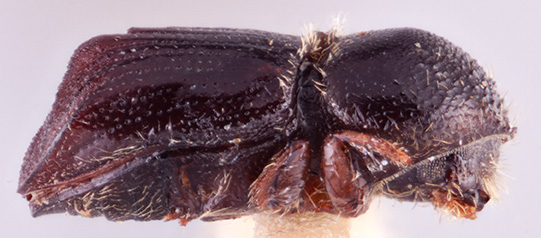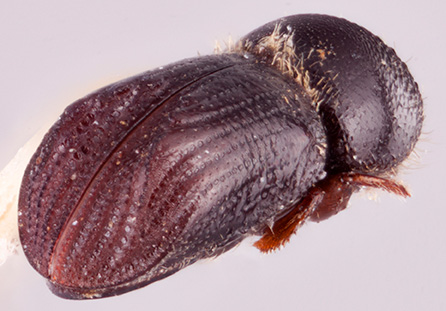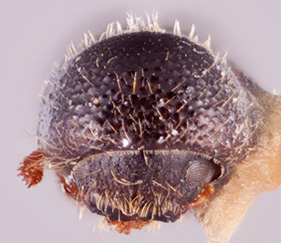Coptodryas carinata
|
Coptodryas carinata holotype lateral; R.K. Osborn |
|
Coptodryas carinata holotype dorsal; R.K. Osborn |
|
Coptodryas carinata holotype declivity; R.K. Osborn |
|
Coptodryas carinata holotype frontal; R.K. Osborn |
Taxonomic history
Coptodryas carinata Smith, Beaver & Cognato 2020 (in Smith et al. 2020bSmith et al. 2020b:
Smith SM, Beaver RA, and Cognato AI. 2020b. A monograph of the Xyleborini (Coleoptera, Curculionidae, Scolytinae) of the Indochinese Peninsula (except Malaysia) and China. ZooKeys 983: 1-442. https://doi.org/10.3897/zookeys.983.52630): 159.
Diagnosis
2.70 mm long (n = 1); 2.70 times as long as wide. This species can be distinguished by the dense tuft of setaeseta:
small hair-like or scale-like structure
along the elytralelytral:
pertaining to the elytra
basebase:
point or edge closest to the body; opposite of apex extending to interstriaeinterstria:
extending to interstriaeinterstria:
longitudinal spaces along the elytra between the striae, which is not as<br />
impressed and bear smaller punctures.
 8; body glabrousglabrous:
8; body glabrousglabrous:
smooth, devoid of vestiture
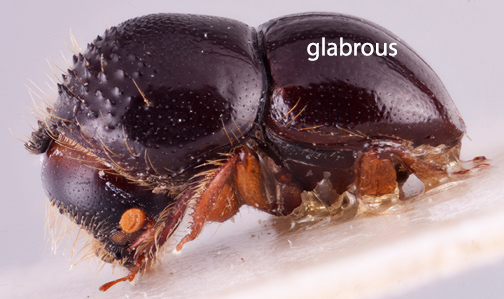 except for pronotalpronotal:
except for pronotalpronotal:
pertaining to the pronotum
and elytralelytral:
pertaining to the elytra
bases; striaestria:
punctures in rows, which may or may not be impressed to make grooves and interstriaeinterstria:
and interstriaeinterstria:
longitudinal spaces along the elytra between the striae, which is not as<br />
impressed and bear smaller punctures.
 uniseriate punctatepunctate:
uniseriate punctatepunctate:
set with fine impressed points, appearing as pin pricks
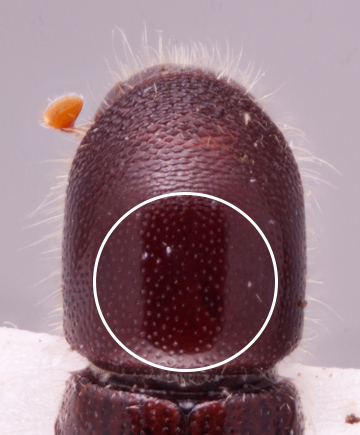 ; elytralelytral:
; elytralelytral:
pertaining to the elytra
discdisc:
the flat central upper surface of any body part (e.g. pronotum and elytra) strongly shiningshining:
strongly shiningshining:
appearing glossy or bright in luster; referring to a surface that is polished and reflects light well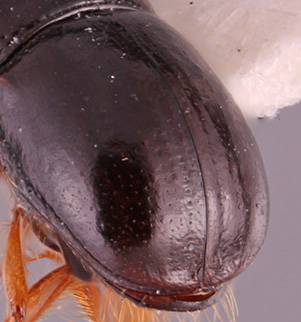 , declivitydeclivity:
, declivitydeclivity:
downward slope of either the pronotum or elytra
 shagreened; basalbase:
shagreened; basalbase:
point or edge closest to the body; opposite of apex half of declivitydeclivity:
half of declivitydeclivity:
downward slope of either the pronotum or elytra
 strongly sulcatesulcate:
strongly sulcatesulcate:
deeply furrowed or grooved
, sulcatesulcate:
deeply furrowed or grooved
area ‘v’ shaped, margined by costate interstriaeinterstria:
longitudinal spaces along the elytra between the striae, which is not as<br />
impressed and bear smaller punctures.
 3, 5, 6, and sharply carinate interstriaeinterstria:
3, 5, 6, and sharply carinate interstriaeinterstria:
longitudinal spaces along the elytra between the striae, which is not as<br />
impressed and bear smaller punctures.
 4; apicalapex:
4; apicalapex:
point or edge furthest from the body; opposite of base
 half of declivitydeclivity:
half of declivitydeclivity:
downward slope of either the pronotum or elytra
 sub convexconvex:
sub convexconvex:
appearing rounded , interstriaeinterstria:
, interstriaeinterstria:
longitudinal spaces along the elytra between the striae, which is not as<br />
impressed and bear smaller punctures.
 costate, denticulatedenticulate:
costate, denticulatedenticulate:
covered in denticles
to apexapex:
point or edge furthest from the body; opposite of base
 ; posterolateralposterolateral:
; posterolateralposterolateral:
relating to end of the side part/portion
 margin carinate to interstriaeinterstria:
margin carinate to interstriaeinterstria:
longitudinal spaces along the elytra between the striae, which is not as<br />
impressed and bear smaller punctures.
 7; protibiaprotibia:
7; protibiaprotibia:
tibia of the first pair of legs
obliquely triangular; pronotumpronotum:
the dorsal surface of the thorax
rounded, robust (type 5) when viewed laterally, and basic (type 2) when viewed dorsally.
May be confused with
Coptodryas amydra, C. concinna, C. elegans, and C. nudipennis
Distribution
China (Yunnan)
Host plants
recorded from Castanopsis indica (Fagaceae) (Smith et al. 2020bSmith et al. 2020b:
Smith SM, Beaver RA, and Cognato AI. 2020b. A monograph of the Xyleborini (Coleoptera, Curculionidae, Scolytinae) of the Indochinese Peninsula (except Malaysia) and China. ZooKeys 983: 1-442. https://doi.org/10.3897/zookeys.983.52630)
DNA data
specimens not available for sequencing

